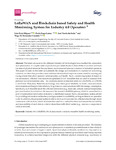| dc.contributor.author | Froiz-Míguez, Iván | |
| dc.contributor.author | Fraga-Lamas, Paula | |
| dc.contributor.author | Varela-Barbeito, José | |
| dc.contributor.author | Fernández-Caramés, Tiago M. | |
| dc.date.accessioned | 2020-05-08T14:53:30Z | |
| dc.date.available | 2020-05-08T14:53:30Z | |
| dc.date.issued | 2019-11-14 | |
| dc.identifier.citation | Froiz-Míguez, I.; Fraga-Lamas, P.; Varela-Barbeito, J.; Fernández-Caramés, T.M. LoRaWAN and Blockchain based Safety and Health Monitoring System for Industry 4.0 Operators. Proceedings 2020, 42, 77. | es_ES |
| dc.identifier.issn | 2504-3900 | |
| dc.identifier.uri | http://hdl.handle.net/2183/25529 | |
| dc.description.abstract | [Abstract] The latest advances in the different Industry 4.0 technologies have enabled the automation and optimization of complex tasks of production processes thanks to their ability to monitor and track the state of physical elements like machinery, environmental sensors/actuators or industrial operators. This paper focuses on the latter and presents the design and evaluation of a system for monitoring industrial workers that provides a near real-time decentralized response system aimed at reacting and tracing events that affect operator personal safety and health. Such a monitoring system is based on the information collected from sensors encapsulated in IoT wearables that are used to measure both personal and environmental data. The communications architecture relies on LoRaWAN, an LPWAN (Low-Power Wide-Area Network) technology that offers good reliability in harsh communications environments and that provides relatively long distance communications with low-energy consumption. Specifically, each wearable sends the collected information (e.g., heart rate, altitude, external temperature, gas concentration, location) from the sensors to the nearest LoRaWAN gateway, which is transmitted to a pool of nodes where information is stored in a distributed manner. Such a decentralized system allows for providing information redundancy and guarantees its availability as long as there is an operative node. In addition, the proposed system is able to store and to process the collected data through smart contracts in a blockchain, which eliminate the need for a central backend and ensure the traceability and immutability of such data in order to share them with third parties (e.g., insurance companies or medical services). | es_ES |
| dc.description.sponsorship | Xunta de Galicia; IN853B-2018/02 | es_ES |
| dc.language.iso | eng | es_ES |
| dc.publisher | M D P I AG | es_ES |
| dc.relation.uri | https://doi.org/10.3390/ecsa-6-06577 | es_ES |
| dc.rights | Atribución 4.0 España | es_ES |
| dc.rights.uri | http://creativecommons.org/licenses/by/4.0/es/ | |
| dc.subject | Industry 4.0 | es_ES |
| dc.subject | LoRaWAN | es_ES |
| dc.subject | Blockchain | es_ES |
| dc.subject | Smart contracts | es_ES |
| dc.subject | Wearable | es_ES |
| dc.subject | Health monitoring | es_ES |
| dc.subject | Safety | es_ES |
| dc.title | LoRaWAN and Blockchain based Safety and Health Monitoring System for Industry 4.0 Operators | es_ES |
| dc.type | info:eu-repo/semantics/conferenceObject | es_ES |
| dc.rights.access | info:eu-repo/semantics/openAccess | es_ES |
| UDC.journalTitle | Proceedings | es_ES |
| UDC.volume | 42 | es_ES |
| UDC.issue | 1 | es_ES |
| UDC.startPage | 77 | es_ES |
| dc.identifier.doi | 10.3390/ecsa-6-06577 | |
| UDC.conferenceTitle | The 6th International Electronic Conference on Sensors and Applications | es_ES |






